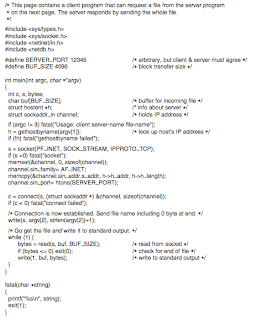- Introduction to transport service and its service to application layer
- provide efficient, reliable, and cost-effective data transmission to users
- software/hardware within layer is called transport entity
- located in the os kernel, or library package in network apps, separate user process or network interface card
- links application or session layer to network layer
- two types of transport service
- both have 3 phases
- establishment
- data transfer
- release
- Addressing and flow control similar to network layer
- difference between network and transport layer despite similarities?
- transport code is all run on users machines
- network runs on routers
- users have little control over network layer
- if packets lost or mangled, transport layer corrects for errors and asks for retransmit
- if connection lost, transport layer sets up new link
- makes transport service more reliable than network
- programmers can write code that works on a variety of networks without dealing with reliability of network
- bottom 4 layers
- transport service provider
- upper layers
- transport service user
Transport Service Primitives
- many programs require transport entities, but few require network services/entities because those are hidden
- five primitives
- LISTEN
- block until process tries to connect
- CONNECT
- attempts to establish a connection
- SEND
- sends data/information
- RECEIVE
- blocks until data packet arrives
- DISCONNECT
- releases connection
- segments
- messages sent from transport entity to transport entity
- TCP or UDP will use this term, older protocols may call segments TPDU(Transport Protocol Data Unit)
- segments exchanged by transport layer are contained in
- packets exchanged by network layer
- packets contained in frames exchanged by data link layer
- when frame arrives
- data link layer processes frame header, if match
- passes contents up to network, if packet header match
- pass up to transport layer
- Client-Server
- CONNECT call causes connection request segment sent to server
- on arrivale transport checks to see if server blocked
- if it is unblocks server and sends connection accepted segment back to client
- when connection accepted arrives client unblocked
- data can be now be sent and receive with SEND RECEIVE
- In transport even one direction data exchange is more complicated than network layer, every data packet gets ack eventually
- control segments also gets ack, managed by transport entities
- transport entities don't need to worry about timer/retransmit
- When connection no longer needed DISCONNECT primitive
- asymmetric disconnect either can issue disconnect
- symmetric variant each side closed separately
Berkeley Sockets
- socket primitives used for TCP
- Server side
- The SOCKET primitive creates new endpoint, allocates space for it within transport entity
- returns ordinary file descriptor, kind of like OPEN on a file
- sockets don't have network addresses
- BIND primitive assign sockets network address
- remote clients can now connect
- LISTEN primitive allocates space to queue to incoming calls for several clients to try to connect
- not blocking call
- ACCEPT primitive returns file descriptor for read and write
- creates a new socket with same properties as original and returns file descriptor for it
- server can now fork process or thread
- Client Side
- SOCKET primitive to be created, but BIND not necessary
- CONNECT primitive blocks the caller and starts connection
- both sides can now use SEND and RECEIVE
- Connection release is symmetric
- CLOSE connection is released
- socket API is often used with TCP to create a reliable byte stream
- DCCP(Datagram Congestion Controlled Protocol)
- version of UDP with congestion control Kohler et al 2006
- sockets probably not final word, structure for congestion control suboptimal because applied separately to each stream, and one stream per object
- SCTP(Stream Control Transmission Protocol)
- SST(Structured Stream Transport)
An Example of Socket Programming: An Internet File Server
Client
Server
- Server code
- includes standard headers
- defines SERVER_PORT
- any number will work between 1024 and 65535, 1023 below is reserved
- local server code begins
- call to memset sets data structure to 0
- htonl and htons convert values to standard format so code runs correctly on both little endian machines and big endian machines
- server creates sockets and checks for errors
- setsockopt is needed to allow port to be reused so run indefinitely
- now ip address is bound to socket, check to see if bind succeed
- then call to listen to server's willingness to accept incoming call, and tell system ot hold up to QUEUE_SIZE
- server enters main loop which never leaves
- call to accept locks, if accept call succeeds
- returns socket descriptor that can read and write to pipes, unidirectional
- sockets bidirectional
- after connection established, the server reads file name
- if name not available, block to wait for file name
- when file name received open file and alternately, read blocks and write them to socket until file copied, then waits for next file
- Client Code
- invoked, only works if server is already running
- if call success file transfer to internet written to f after which client exits
- starts with right number of arguments
- socket created and initialized
- client attempts to establish TCP connection using CONNECT
- procedure fatal prints error and exits, since compile separately can't share code of fatal



No comments:
Post a Comment